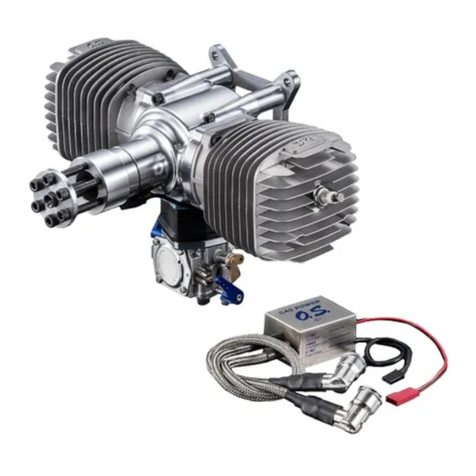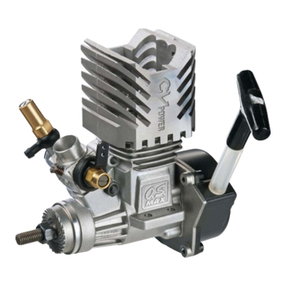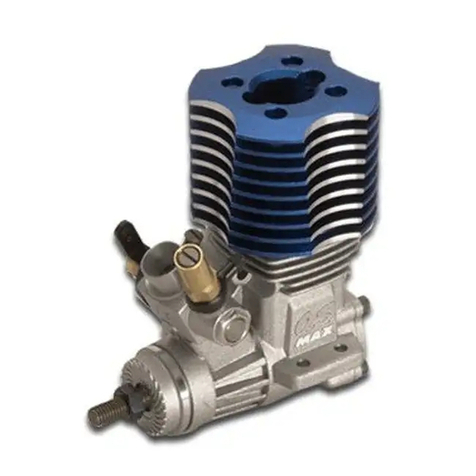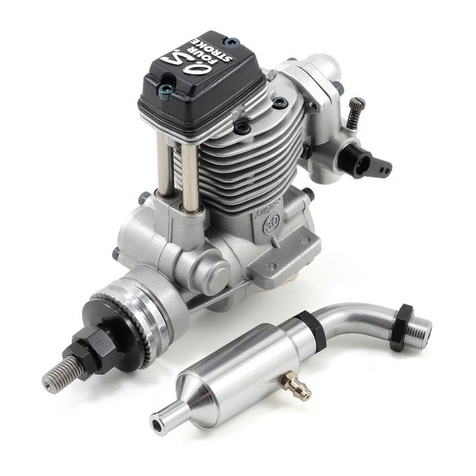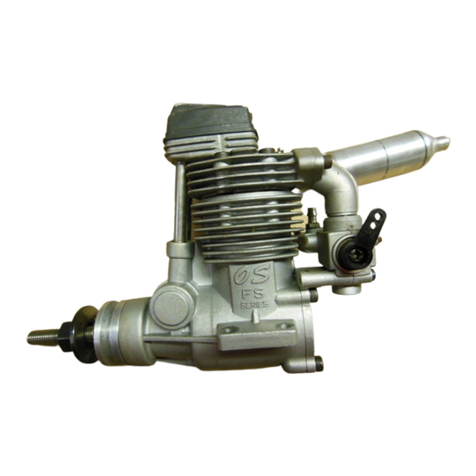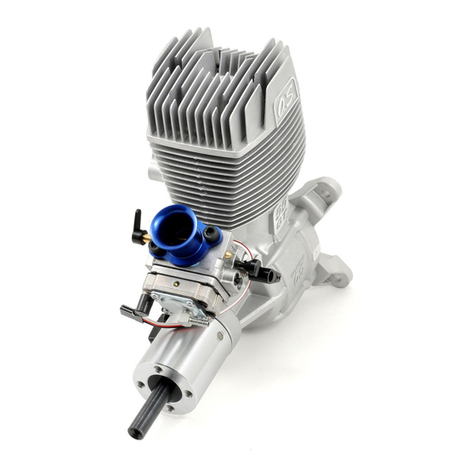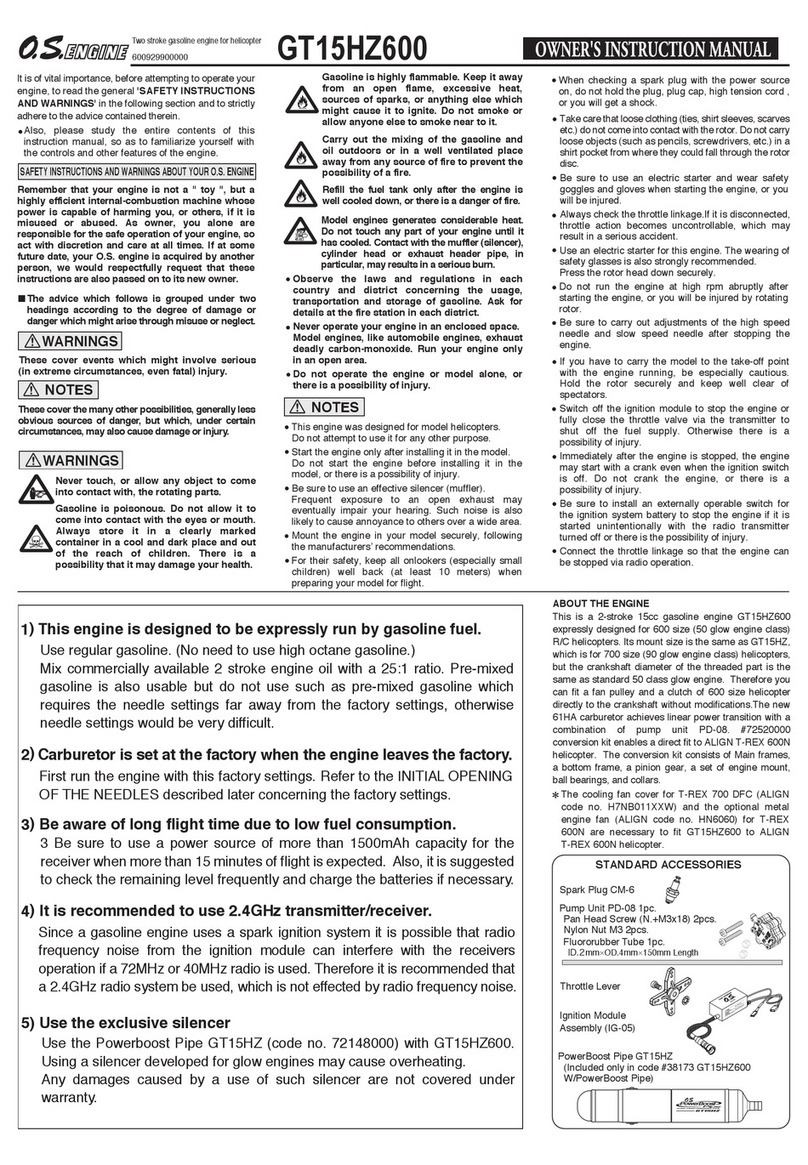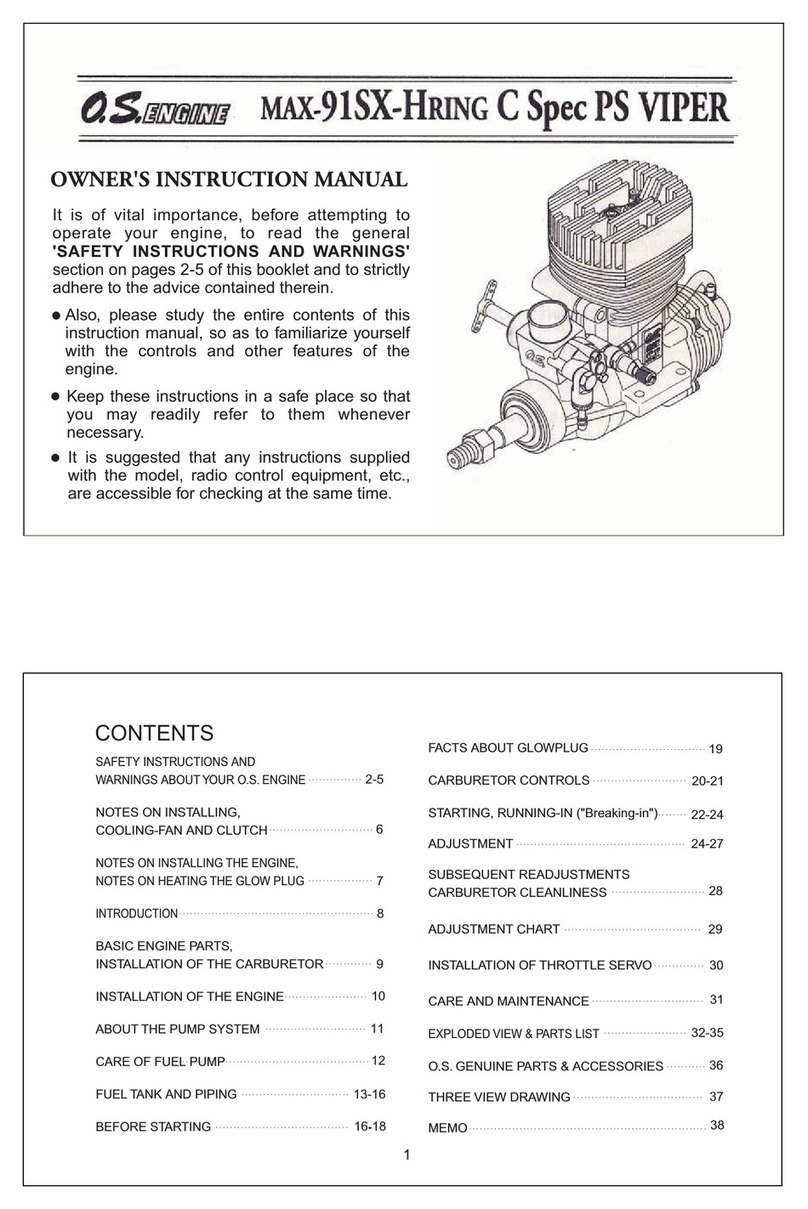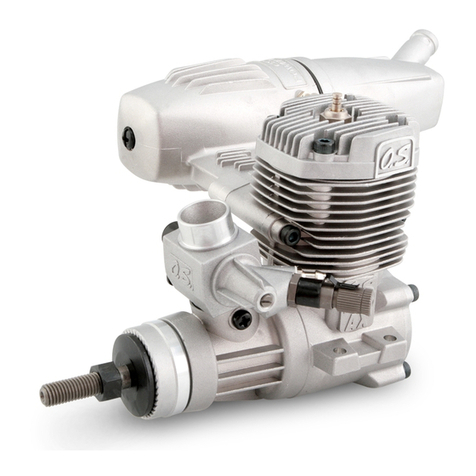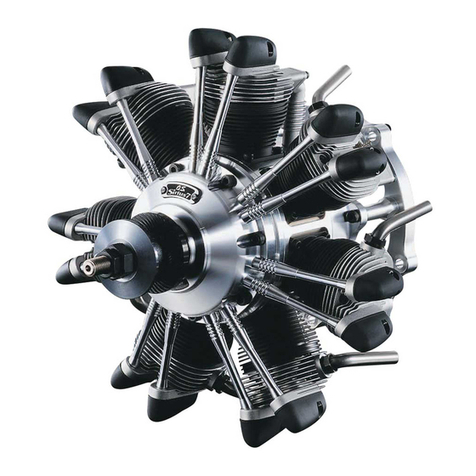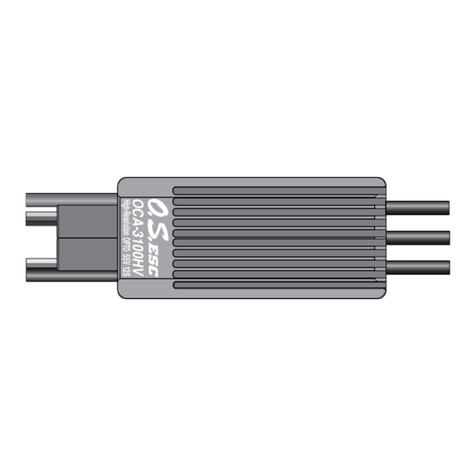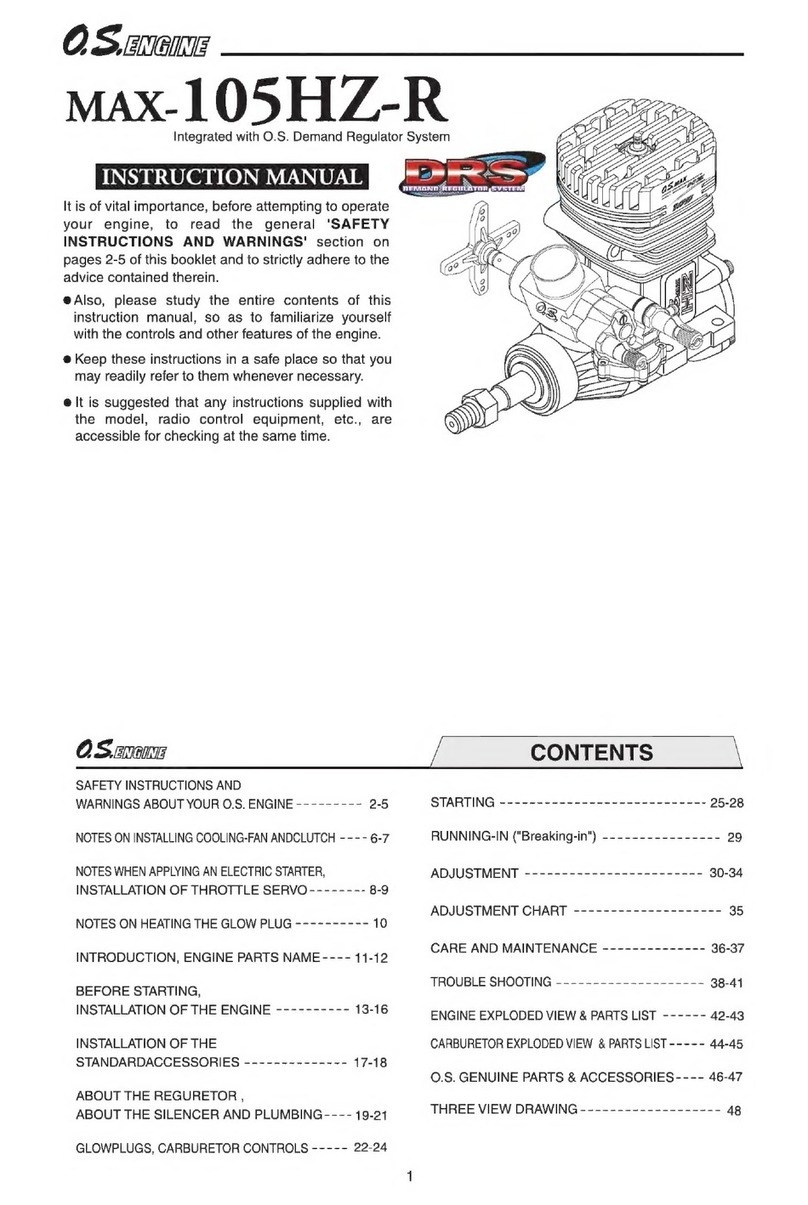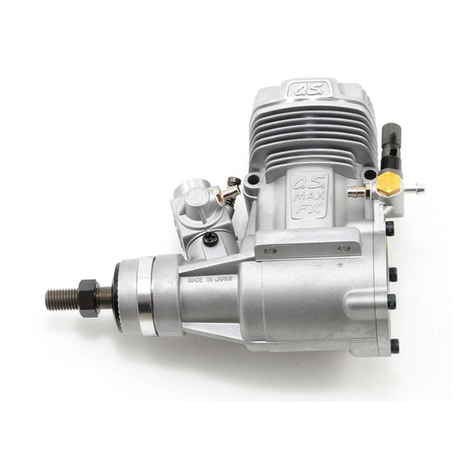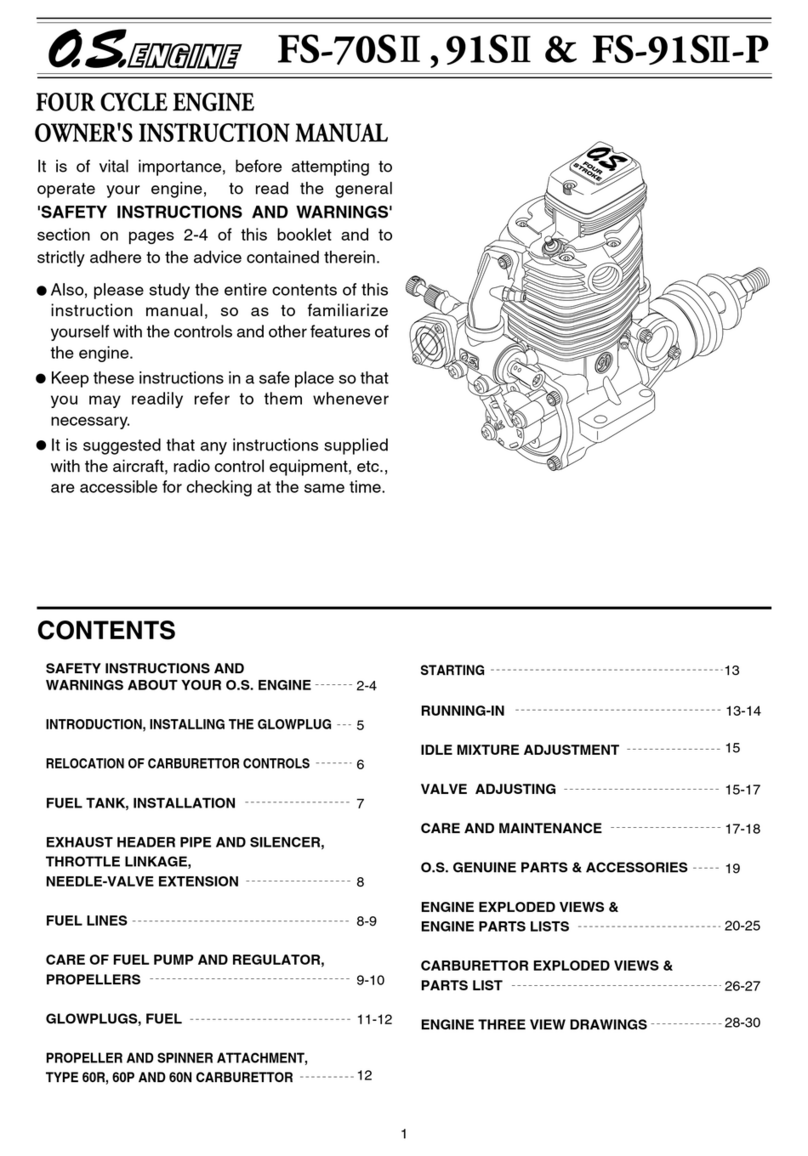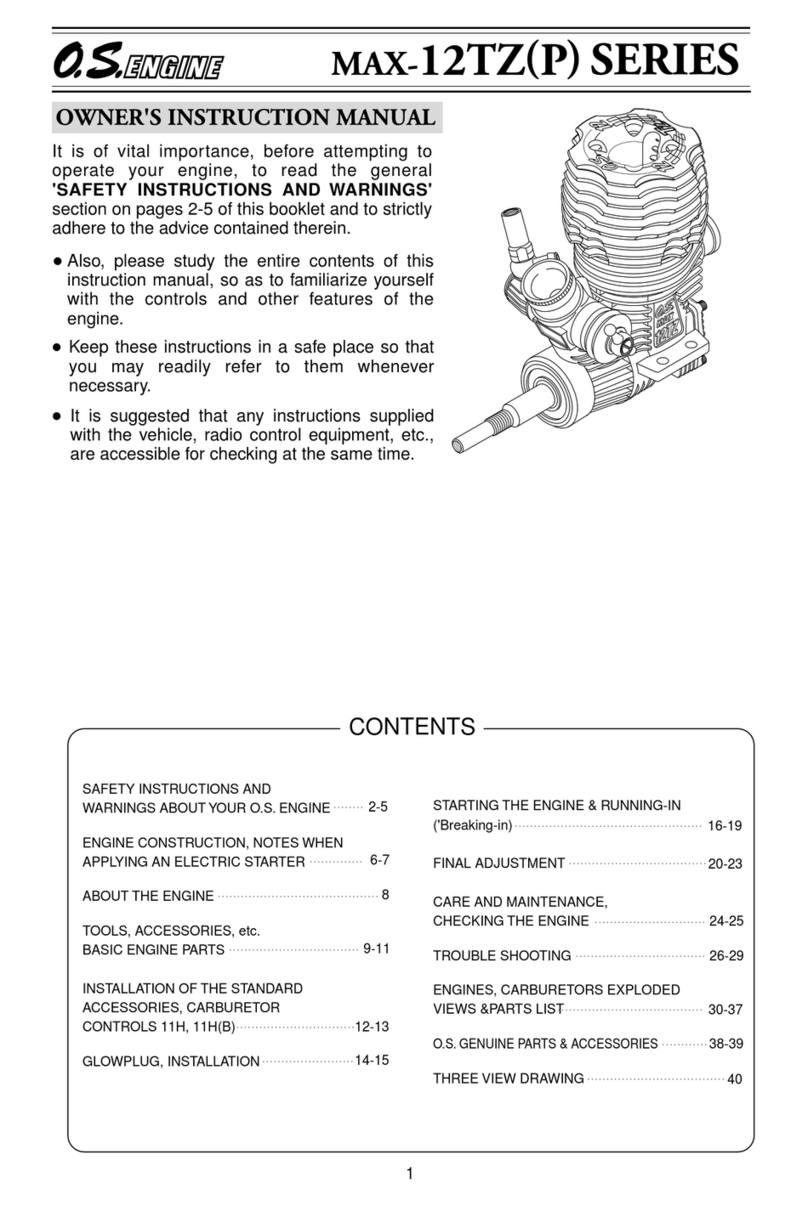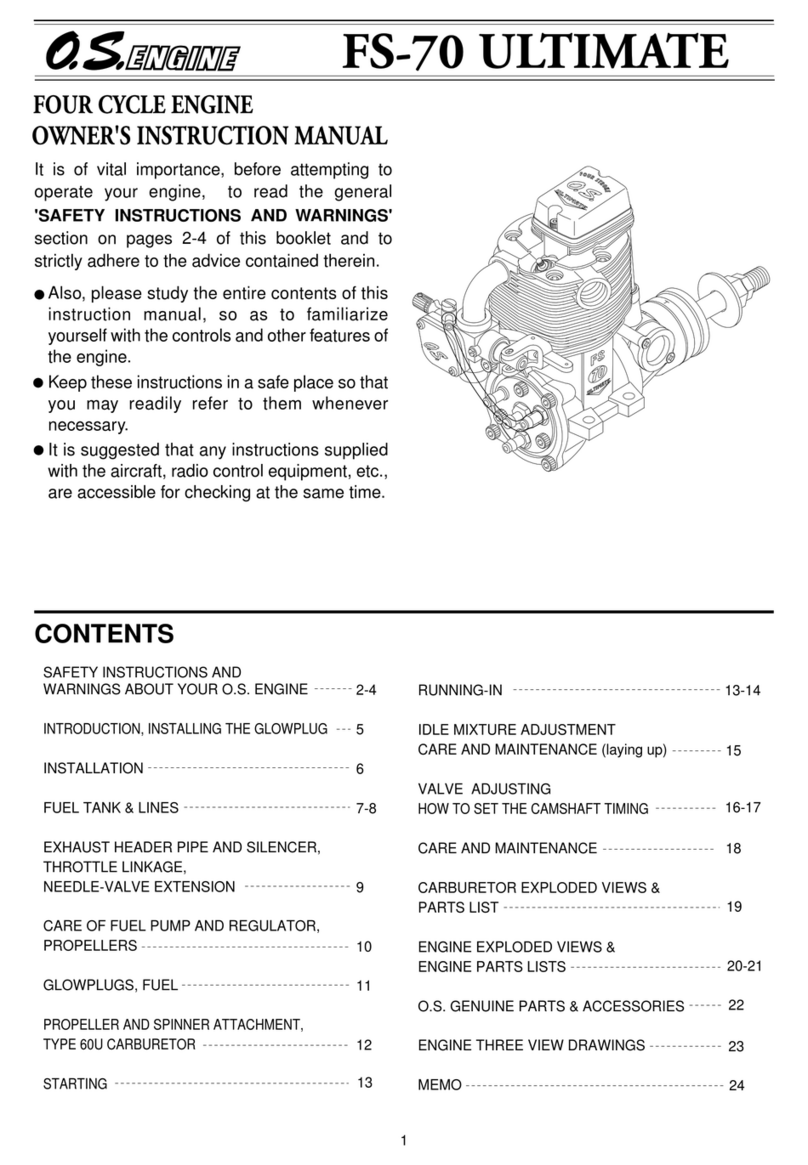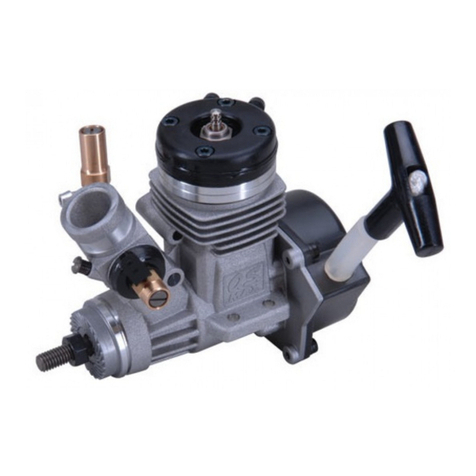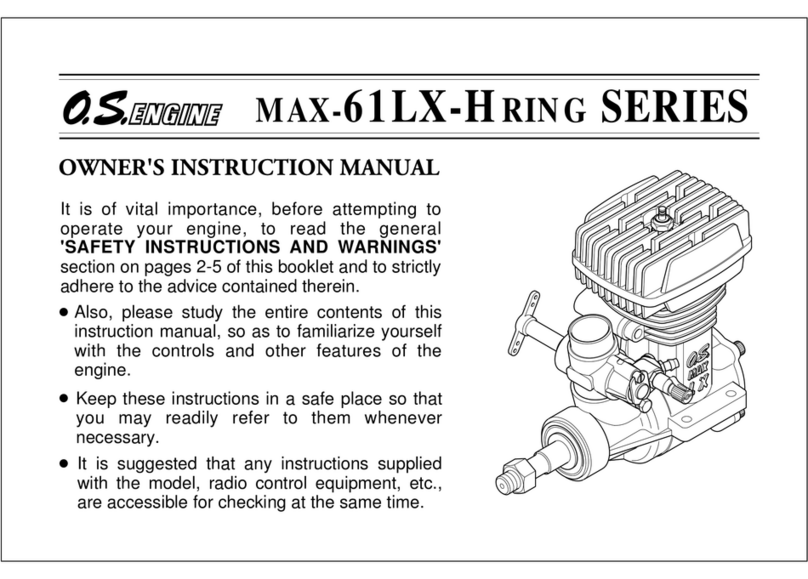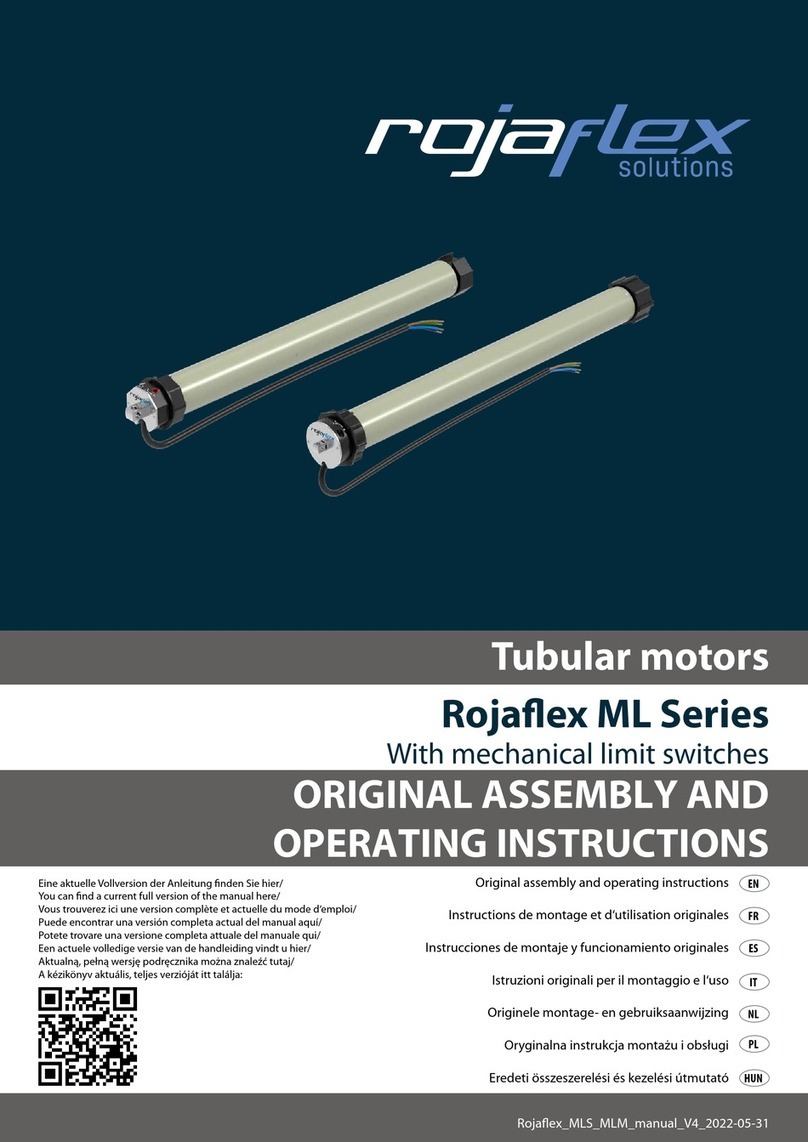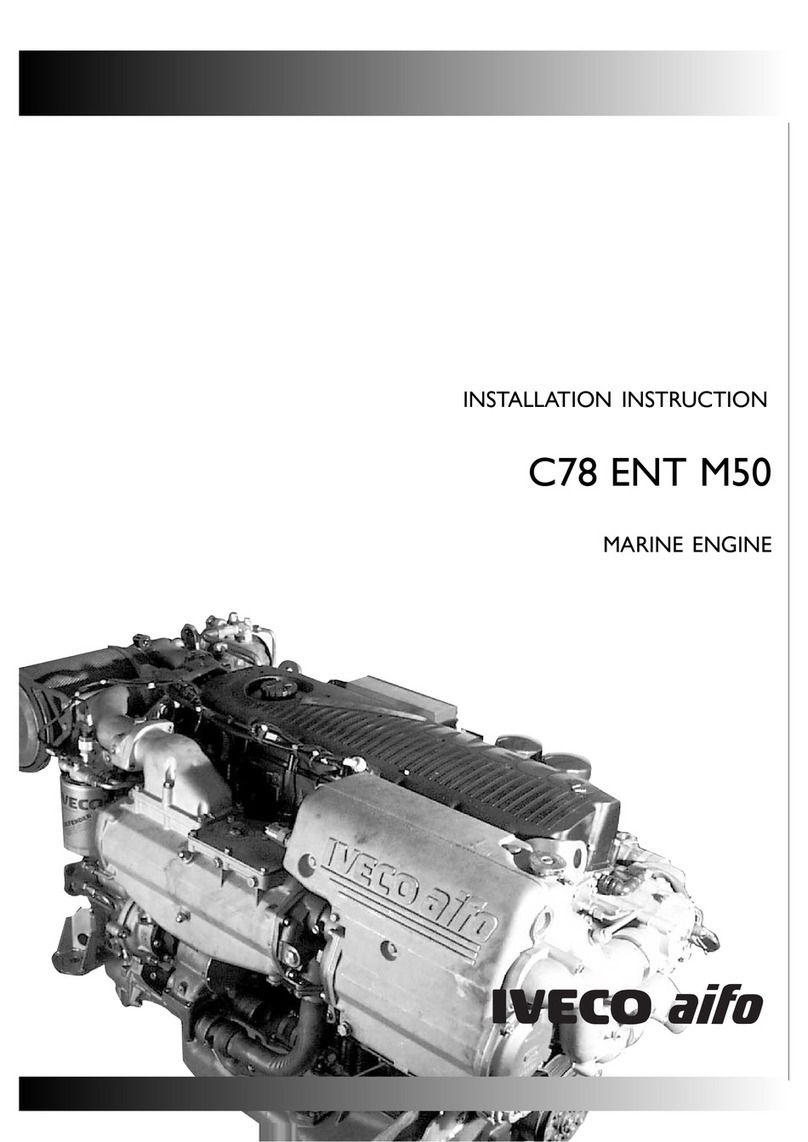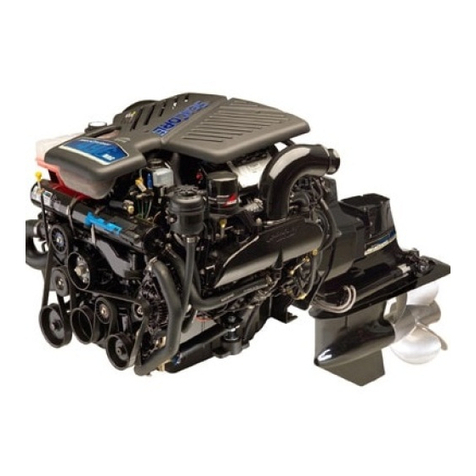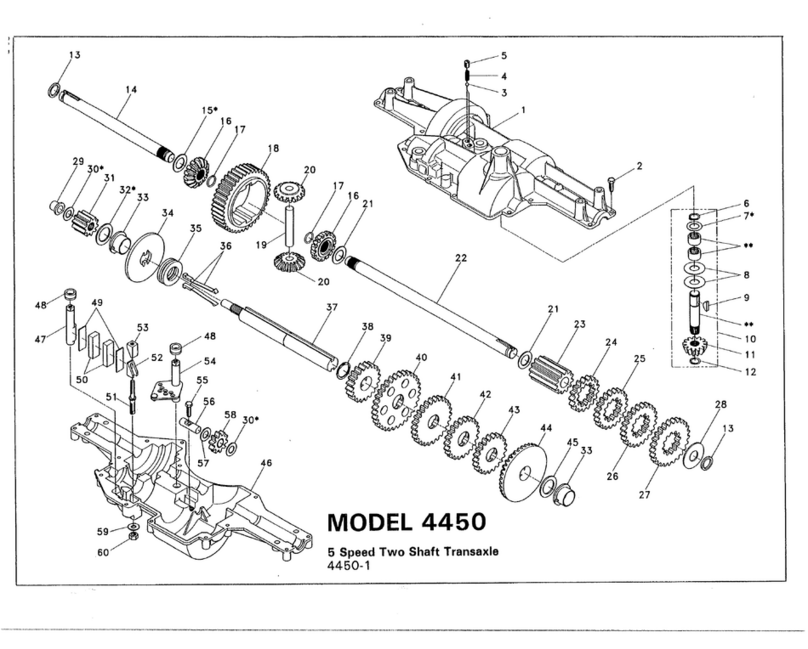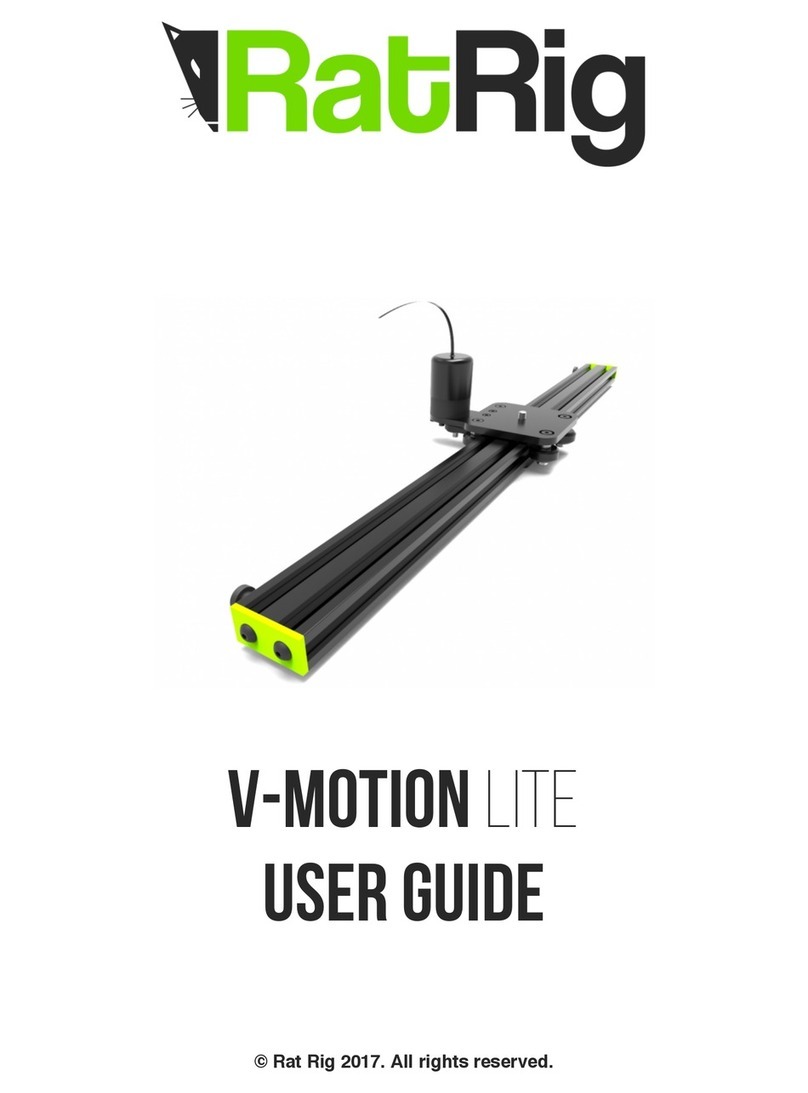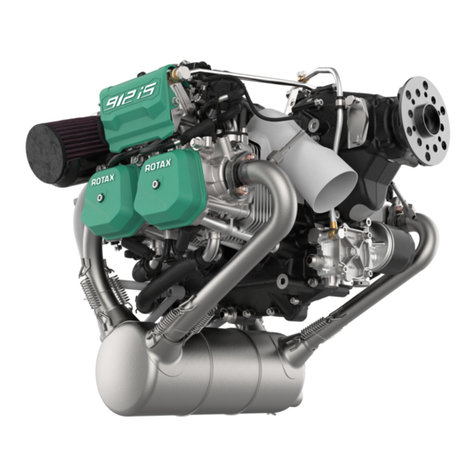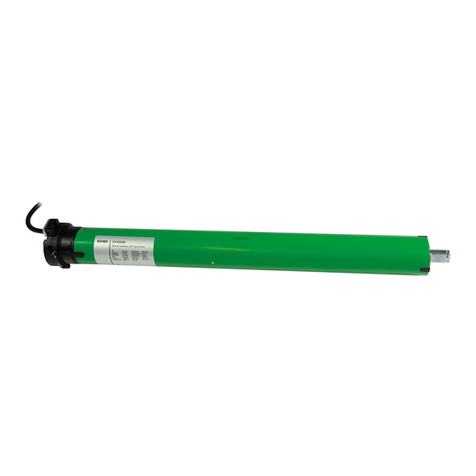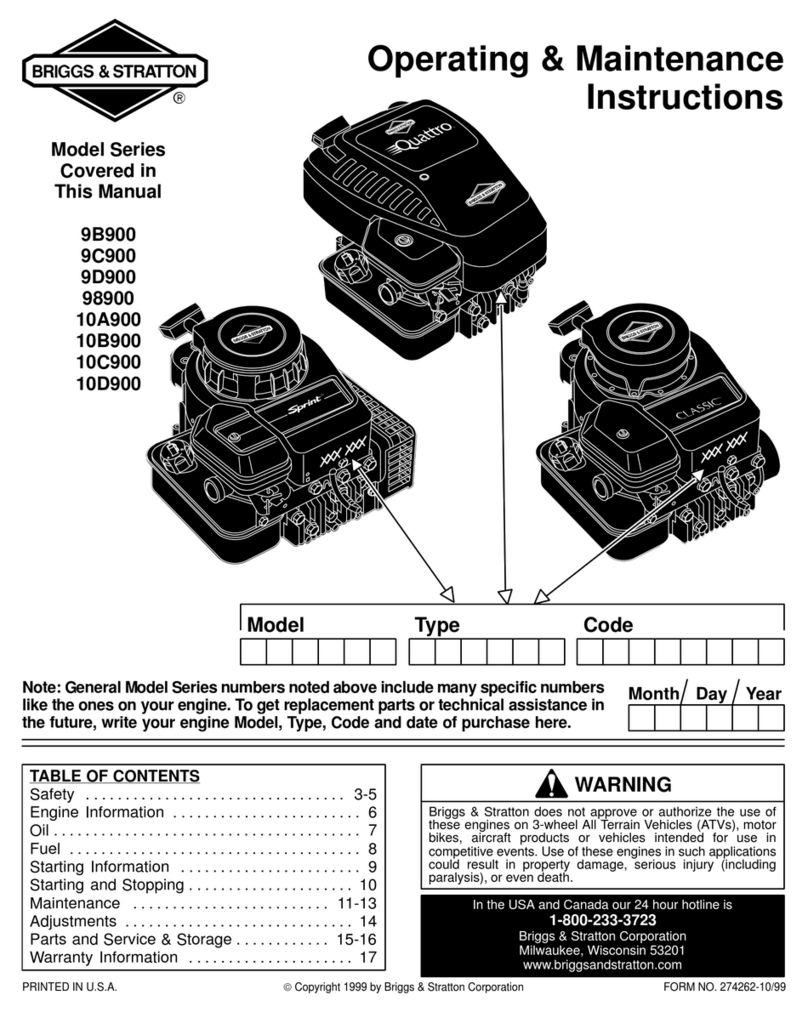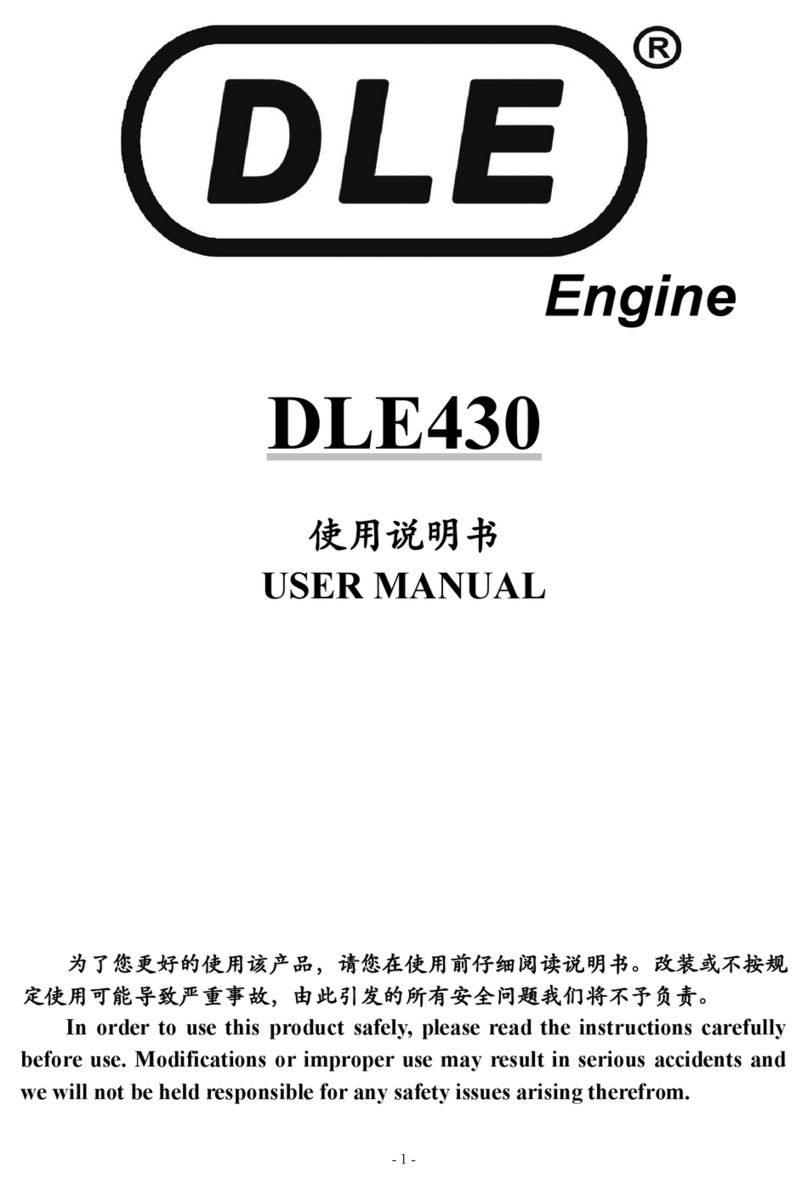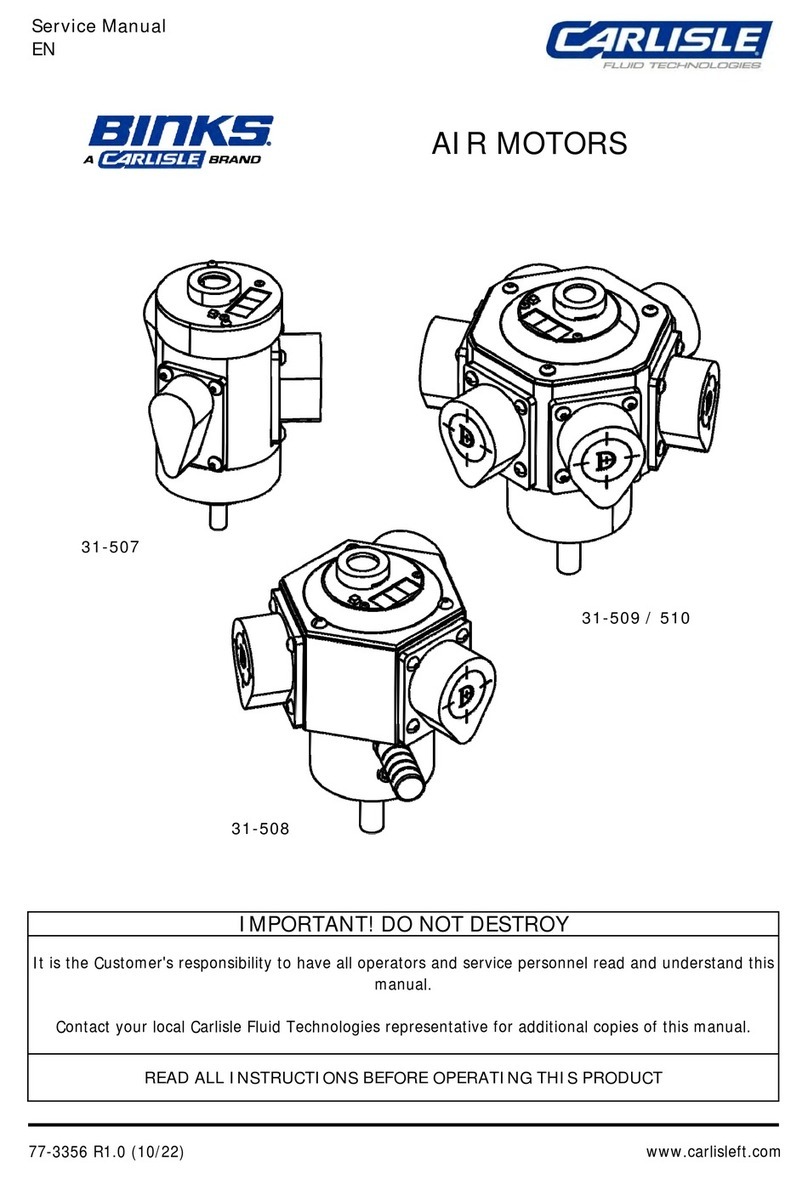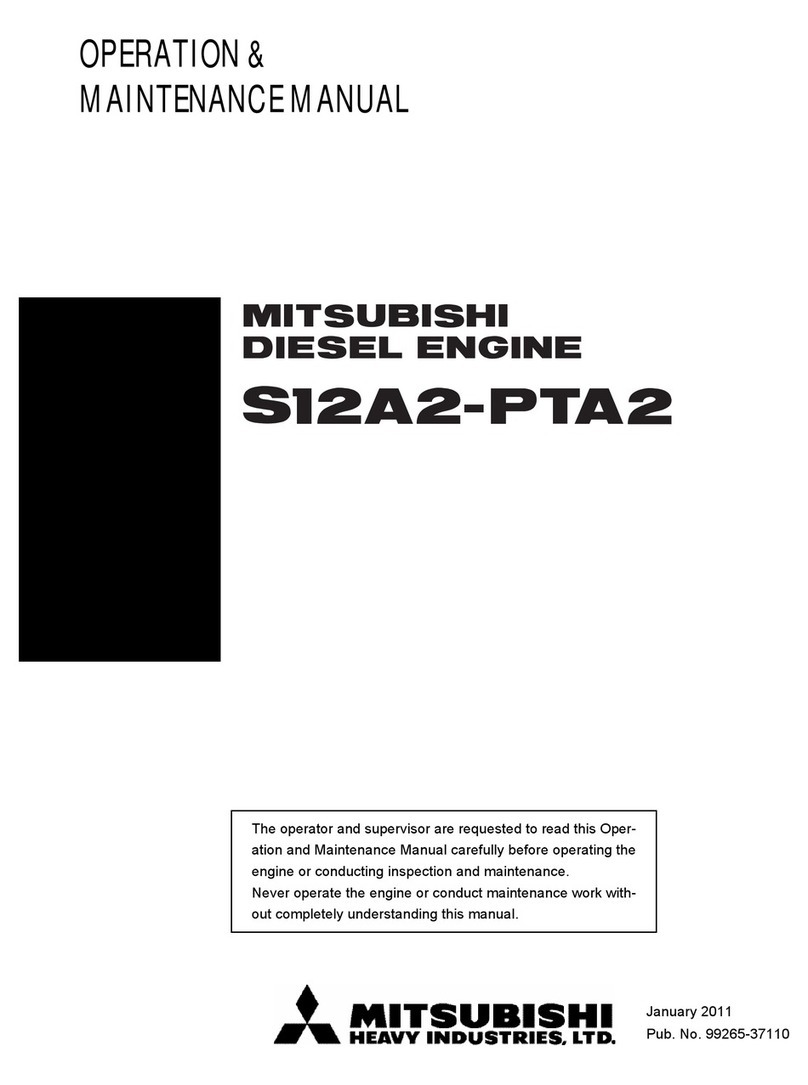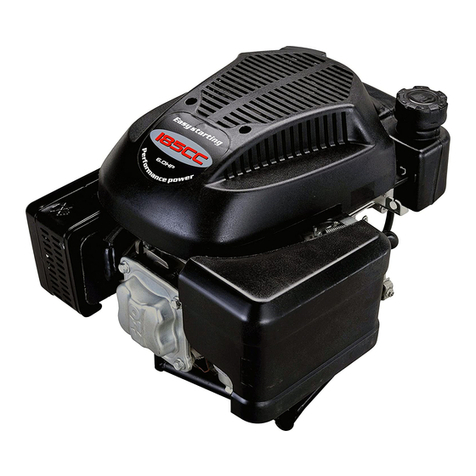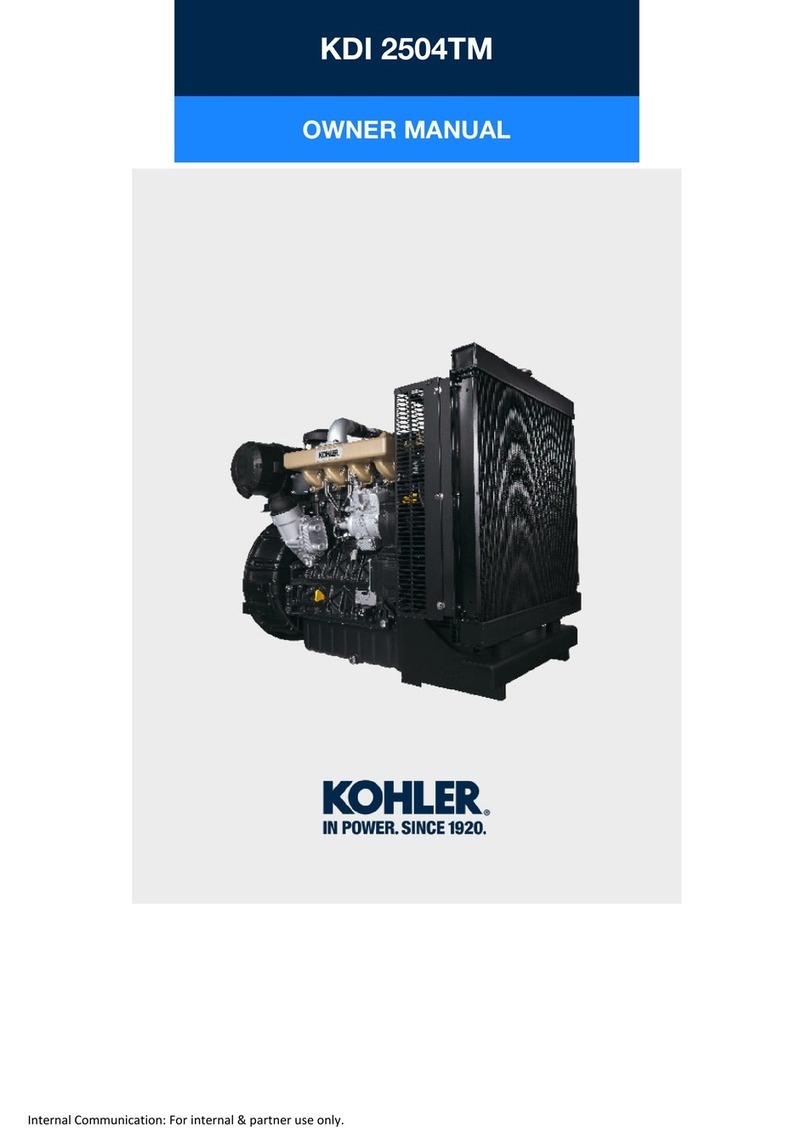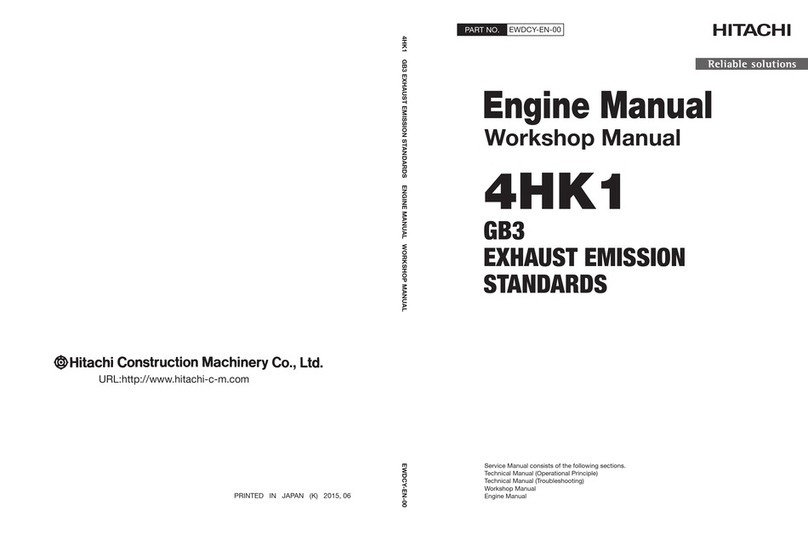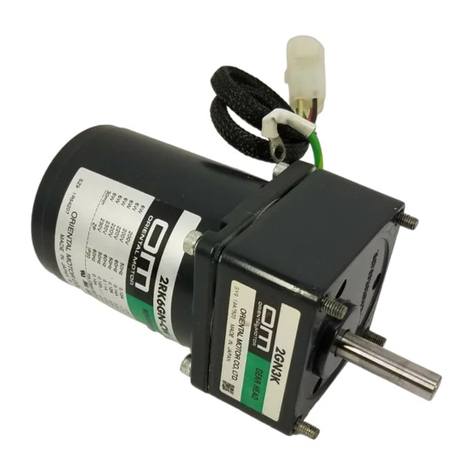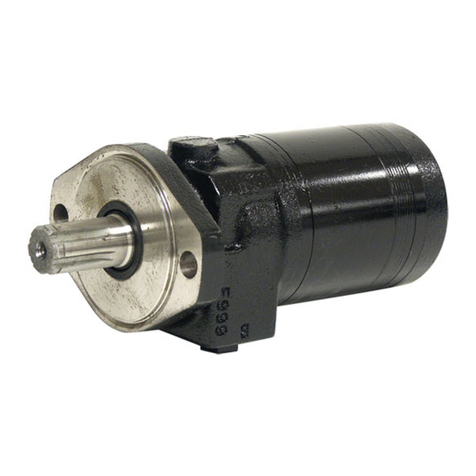
RUNNING-IN ("Breaking-in")
ADJUSTMENT
CARE AND MAINTENANCE
Please pay attention to the matters described
below to ensure that your engine serves you well
in regard to performance, reliability and long life.
As previously mentioned, it is vitally important to
avoid operating the engine in conditions where dust,
disturbed by the propeller, may be deposited on the
engine and enter its working parts.
Remember to keep your fuel container closed to
prevent foreign matter from contaminating the fuel.
Install a fuel filter to prevent foreign matter in the fuel
container from entering the fuel tank. O.S. Super
Filters (L) and (S) are available as optional extras.
Install an in-line fuel filter between the tank and
carburetor to prevent foreign matter in the tank from
entering the carburetor.
If these precautions are neglected, restriction of fuel
flow may cause the engine to cut out, or the fuel/air
mixture to become too lean causing the engine to
overheat.
Clean these filters periodically.
The use of modern high-performance alcohol based
model engine fuels, while promoting cooler running,
improved anti-detonation combustion and increased
power, have the disadvantage of causing corrosion
due to the acid by-products of combustion.
The use of nitromethane in the fuel can also
contribute to the problem.
Do not close the needle-valve and mixture control
valve too far as this will cause a lean setting and
over heating of the engine. This can, in turn, create
nitromethane oxide leading to internal rusting of the
engine. Always adjust the needlevalve slightly on the
rich side of peak rpm.
Do not leave unused fuel in the engine at the
conclusion of a day’s flying. Accepted practice is to
cut off the fuel supply while the engine is still running
at full throttle, then expel as much fuel residue as
possible by turning the engine over 5-10 seconds
with the electric starter.
Finally, inject some after-run oil through the glowplug
hole and turn the engine over several times by hand.
Stopping the engine
Fully pull down the throttle trim on the transmitter.
Starting
Preparation of starting
7.
8.
9.
In case the engine does not stop.
Hold the rotor head, and pinch the fuel line to stop the
fuel supply. If it still does not stop, pull off the fuel line
from the carburetor. It is necessary to readjust the
throttle linkage so that the carburetor rotor is fully
closed when the throttle stick and throttle trim on the
transmitter are fully pulled Down.
NOTE:
If the throttle response is poor or the engine stops
due to a temporarily over-rich mixture immediately
after the engine is started, pinch the fuel line for
one or two seconds until the engine r.p.m.
increase and the engine runs steadily.
SUBSEQUENT READJUSTMENTS
CARBURETOR CLEANLINESS
Remove this with
an 8mm wrench
Dirt and foreign matter
mostly accumulate here
6. Priming
5. Inserting the starter shaft
Insert the starting shaft into the shaft
cup securely.
Without energizing the glowplug,
open the throttle a little from the idle
position. Turn the engine over using
the starter until the fuel is seen to
reach the carburetor.
Connect the battery to the glowplug and start the
engine by applying the starter. When started, switch
off the starter and withdraw the starting shaft after
making sure the rotation of the starter shaft stops.
Hold the rotor head by hand so that
rotor cannot rotate when the engine
is Started. Also, steady the model
with a foot on the landing gear skid.
Make sure that the transmitter throttle
stick is at the fully closed position and
the throttle trim at center position, and
make sure that idle-up switch on the
transmitter is off.
All internal-combustion engines benefit, to some
degree, from extra care when they are run for the first
few times known as running-in or breaking-in.
This allows the working parts to mate together under
load at operating temperature.
However, because O.S. engines are made with the aid
of the finest modern precision machinely and from the
best and most suitable materrials, only a very short
and simple running-in procedure is required and can
be carried out with the engine installed in the model.
For the first few flights with a new engine i.e. while the
engine is being run-in set the needle-valve for a
slightly rich mixture not excessively rich as this may
result in poor throttle response and cause the engine
to stop.
About 1.5 turn open from the nomal setting will usually
suffice.
The following adjustments are approximately correct
when using a fuel containing 18-25% lubricant and
10-30% nitromethane.
Bear in mind that fuels containing relatively large
percentages of power-boosting nitromethane operate
at richer mixture settings than are needed for mild
fuels and will, therefore, require the Needle Valve to be
readjusted accordingly. The type and percentage of
lubricant used is also a factor here, as noted later in
these instructions.
This carburetor is not equipped with a throttle stop
screw. Instead, idle speed is adjusted by means of
the throttle trim lever on the transmitter.
This enables the full r.p.m. range, from idle to full
power, to be controlled by the throttle stick, and then
allows the engine to be stopped, from the
transmitter, by closing the throttle completely with
the trim lever.
As a safety measure, first check the transmitter
controls, including the throttle stick and trim lever
positions, and hold the main rotor securely before
starting the engine.
Warm the engine by allowing it to idle for about 30
seconds. If the engine stops, advance the throttle
trim lever slightly to increase the idle rpm. Then
open the throttle sufficiently to 'float' the model
above the ground.
Set up the throttle linkage as follows:
With the transmitter throttle trim lever fully retarded,
adjust the throttle servo linkage so that the throttle
rotor is (a) fully open when the transmitter throttle
stick is fully advanced and (b) fully
closed (i.e.
engine stopped) when the stick is fully
retarded. The
idle speed is then set by advancing the throttle trim
lever to the point where the engine runs, steadily
and reliably,at the desired idle speed.
lf, at this time, the engine is slow to pick up and produces
an excess of exhaust smoke, the mixture is too rich.
Correct this condition by turning the Mixture Control
Screw clockwise. lf the mixture is extremely rich,
engine rpm will become unstable : opening the throttle
will produce a great deal of smoke and rpm may drop
suddenly or the engine may stop.
This condition may also be initiated by an excessively
prolonged warming-up period.
lf, on the other hand, the mixture is too Iean, this wiIl
be indicated by a marked lack of exhaust smoke and
a tendency for the engine to cut out when the throttle
is opened. ln this case, turn the Mixture Control Screw
counter-clockwise to enrich the mixture.
Turn the Mixture Control Screw 5 degrees at a time.
Hover the model and actuate the throttle to observe
response over the medium speed range. lf the
engine smokes excessiveIy and throttle response is
poor, the mixture is too rich ; in which case, land the
model and turn the Needle Valve clockwise. Do not
close the NeedIe Valve too much, keeping it a little
on the rich side at this stage.
lf, on the other hand, hovering is not stable and
response to the throttIe is over-sensitive, or if the
engine tends to overheat, this indicates that the
mixture is too lean and should be corrected by
turning the Needle Valve counter-clockwise.
Having provisionally set the idle mixture, the next
step is to adjust the mixture for hovering flight.
When satisfactory hovering flight has been achieved,
land the modeI again and re-check the engine's idle
qualities.
Now adjust the Needle Valve to achieve the best
performance when the model is flying at full throttle.
lf, at full throttle, acceleration is poor, the exhaust
unduly smoky and the model fails to reach expected
straight line speed, the mixture is too rich and the
Needle Valve setting will need to be reduced. lf,
however, after smoothly acceIerating to satisfactory
high-speed straight and level flight, power is lost
when the model is puIled up into a climb, the mixture
is too lean. ln this case, land the model immediately
and readjust Needle Valve to a richer setting.
After about 10 seconds of idling, open the throttle to
'float' the model. lf the transition is smooth, the idle
mixture is O.K. If the symptoms of either rich or Iean
running are observed, readjust the Mixture Control
Screw accordingly.
For helicopters, good throttle response at medium r.p.m.
(e.g.hovering speeds) is most important, since this is a
power range widely used in helicopter flight. The
optimum fuel/air mixture strength at medium speeds is
dependent on obtaining balanced adjustment of both the
Needle Valve and the Mixture Control.
lf both controls are already at their optimum setting,
some modification to these settings may be necessary
to achieve satisfactory mid-range throttle response, but
such readjustments should onIy be made within the
range where idle reliability and high-speed performance
are not unduly compromised. Readjustments should
therefore be carried out as follows:
Now re-check hovering performance and, if necessary,
fine-tune the mixture for hovering flight.
lf the mid-range throttle response is not rapid and
positive (indicating a rich mid-range mixture), turn the
Needle Valve 2 or 3 clicks clockwise, or turn the Mixture
Control Screw 1-3 degrees cIockwise.
lf, on the other hand, the response to mid-range
throttle movement is too sensitive (indicating a lean
mid-range mixture), turn the Needle Valve 2 or 3 clicks
counter-clockwise or turn the Mixture Control Screw
1-3 degrees counter-clockwise.
Throttle response at hovering speeds is aIso affected by
the reIationship of the main rotor pitch angle to throttle
opening. If the optimum mid-range throttle response
cannot be obtained by the carburettor adjustments
described above, try adjusting the helicopter's pitch
control characteristics.
The correct functioning of the carburetor depends on
its small fuel orifices remaining clear. The minute
particles of foreign matter that are present in any fuel
can easily partially obstruct these orifices and upset
mixture strength so that engine performance becomes
erratic and unreliable. It is recommended that fuel is
passed through a filter when the tank is filled and that
a good in-line filter is installed between the fuel tank
and carburetor and, furthermore, that this filter is
frequently cleaned to remove foreign matter that
accumulates on the filter screen. Finally, occasionally
remove the needle-valve holder from the carburetor as
shown in Photo and extract any remaining foreign
matter that may have lodged in the location shown in
Photo, right.
Once the engine has been run-in and the carburetor
controls properly set up, it should be unnecessary to
alter the mixture settings, except to make minor
adjustments to the Needle Valve occasionally, to take
account of variations in climatic conditions.
The use of a different fuel, however, particularly one
containing more, or less, nitromethane and / or a
different type or proportion of lubricating oil, is likely to
call for some readjustment of the Needle-Valve.
Remember that, as a safety measure, it is advisable to
increase the Needle Valve opening by an extra
half-turn counter-clockwise, prior to establishing a new
setting. The same applies if the silencer type is
changed. A different silencer may alter the exhaust
pressure applied to the fuel feed and call for a revised
Needle-Valve setting.
The use of a different glowplug, or changes to the
mainrotor and its pitch angles may also require
compensating carburetor readjustments.





